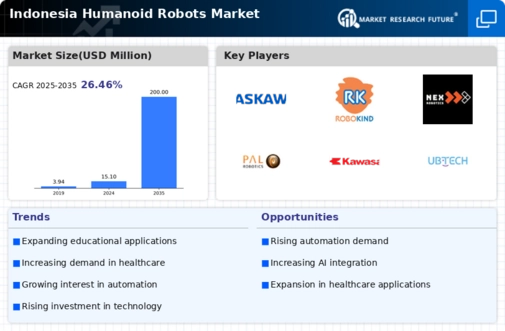The humanoid robots market in Indonesia is characterized by a dynamic competitive landscape, driven by technological advancements and increasing demand across various sectors, including healthcare, education, and entertainment. Key players such as SoftBank Robotics (Japan), Honda (Japan), and UBTECH Robotics (China) are strategically positioning themselves through innovation and partnerships. SoftBank Robotics (Japan) focuses on enhancing its product offerings with advanced AI capabilities, while Honda (Japan) emphasizes the integration of robotics in mobility solutions. UBTECH Robotics (China) is actively pursuing collaborations with educational institutions to promote robotics in learning environments, collectively shaping a competitive environment that prioritizes technological integration and user-centric solutions.
The market structure appears moderately fragmented, with several players vying for market share. Key business tactics include localizing manufacturing to reduce costs and optimize supply chains, which is particularly relevant in the context of Indonesia's growing manufacturing capabilities. The collective influence of these companies fosters a competitive atmosphere where innovation and operational efficiency are paramount, allowing them to respond swiftly to market demands and consumer preferences.
In November 2025, SoftBank Robotics (Japan) announced a partnership with a leading Indonesian university to develop humanoid robots tailored for educational purposes. This strategic move is likely to enhance the company's presence in the educational sector, aligning with the increasing emphasis on STEM education in Indonesia. By integrating robotics into the curriculum, SoftBank Robotics (Japan) not only expands its market reach but also contributes to the development of a skilled workforce in the region.
In October 2025, Honda (Japan) unveiled its latest humanoid robot designed for elderly care, showcasing its commitment to addressing the aging population's needs in Indonesia. This initiative reflects Honda's strategic focus on leveraging robotics to enhance quality of life, potentially positioning the company as a leader in the healthcare robotics segment. The introduction of such technology may also stimulate further investment in healthcare solutions, thereby influencing market dynamics.
In September 2025, UBTECH Robotics (China) launched a new line of humanoid robots aimed at the entertainment industry, featuring advanced interactive capabilities. This launch signifies UBTECH's intent to capture a growing market segment that values immersive experiences. By focusing on entertainment, UBTECH Robotics (China) diversifies its portfolio and enhances its competitive edge, potentially attracting partnerships with entertainment venues and event organizers.
As of December 2025, current trends in the humanoid robots market include a pronounced shift towards digitalization, sustainability, and AI integration. Strategic alliances among key players are increasingly shaping the competitive landscape, fostering innovation and collaborative development. The evolution of competitive differentiation appears to be moving away from price-based competition towards a focus on technological innovation, reliability in supply chains, and the ability to meet specific consumer needs. This shift suggests that companies that prioritize R&D and strategic partnerships will likely emerge as leaders in the market.























Leave a Comment